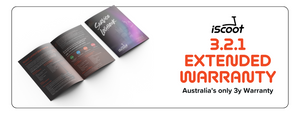Check out these tips how to buy the best electric scooter for kids, without breaking your budget, or their bones.
SCOOTER SAFETY
Kids are precious, so it makes sense to protect their growing bodies with helmets, elbow/ knee shin pads and a range of other safety products available. Something as simple as proper closed footwear means their bare feet, thongs/ flip-flops won’t become stuck or wedged into wheels, while protective gloves and clothing will help prevent grazes and gravel rash. Many kids scooters are kept basic to control costs, so adding items to boost visibility like front and rear LED lights, and reflectors are all worth the extra investment if your child will be travelling near cars, or in low-light situations. There’s a huge range of these types of products available online, and prices are quite reasonable.
Also remember that “low maintenance” does not mean “no maintenance”. Keeping your child’s electric scooter in top condition will maximise scooter safety. Regularly checking the depth of the tyre tread, state of the tyres and replacing brake pads are all critical to safety- but the great news is that we have in-house mechanics that can service your scooter for you. This can help to maximise battery life, keep your motor running smoothly, and your scooter zooming at full power for as long as possible.
Shop our range of products here.
LEARNING TO RIDE AN E-SCOOTER FOR KIDS.
The best approach here is “teach your child how to ride properly”.
Parents take this seriously when kids qualify for their C-class vehicle license, and it’s really not much different with an electric scooter.
E scooters, particularly kid’s scooters, will have smaller wheels than motorcycles or cars – so the scooter will not take well to large bumps or potholes (however tempting they are). To lighten the scooter, devices like shock absorbers are often not built onto children’s models, making them handle differently to other scooters.
Start by going through the manufacturer’s instruction booklet or manual, and ensuring you and your child know what all buttons, levers, and pedals are for.
Move on to taking off slowly and safely, to avoid falls. Most electric scooters have a safe or low-power mode, to prevent your new scooter zooming out from under you! Then slowly work through how to accelerate, slow down, stop quickly, and safely steer around obstructions like rocks or potholes on the road without skidding. Also discuss safety while going up/ down hills, around corners and in crowded spaces.
Make yourself and your child aware of the water rating, whether your chosen model is splash resistant, or should be kept dry.
Be sure your supervise your kids for the first few trips, before letting them take short journeys on their own, and make sure you and your kids are aware of the local regulations governing scooters.
LOCAL RULES AND REGULATIONS, SPECIFIC FOR KIDS
Each state of Australia has differing regulations, so please check with your local State road traffic authority to be certain of the local laws for details regarding:
- mandatory helmets
- speed limits
- age restrictions
- scooter size and capacity
We are located in Queensland, where electric scooters are considered a wheeled recreational device, so they may be used on footpaths only. They may not be used on roads, or designated bicycle lanes.
Riders must be aged 12 or over and supervised by an adult until aged 16.
Helmets are mandatory, and speeds must be limited to 25kph.
Please see more info: https://www.qld.gov.au/transport/safety/rules/wheeled-devices/skateboards and https://www.qld.gov.au/transport/safety/rules/wheeled-devices/personal-mobility-devices
Please view the full information here on the New South Wales Centre for Road Safety site.
New South Wales road rules currently stipulate that “powered foot scooters…cannot be registered and can only be used on private land.” As such, it is illegal to ride an electric scooter anywhere in New South Wales, other than on private property.
Victorian law stipulates that a motorised scooter cannot travel faster than 10km/h. Additionally, a motorised scooter must have a maximum power output of 200 watts or less. Electric scooters that do not meet these stipulations can be used on private property, but not in public. If an electric scooter fails to meet these requirements, it is classified as a motor vehicle. If classified as a motor vehicle, the electric scooter must be registered, and the rider must have a valid motorcycle license.
Please see VicRoads details here .
In South Australia, it is illegal to ride an electric scooter on the road, footpath, bicycle track, or anywhere other than private property. Under South Australian law, electric scooters are considered motor vehicles, with the relevant SA Transport law explaining “operating a motor vehicle requires a driver’s licence, registration and compulsory third party insurance. As these devices [electric scooters] do not meet the safety standards under the Australian Design Rules they are not eligible for registration.”
Currently, Western Australian laws via the motor vehicle licensing branch stipulate that electric scooters must travel at 10km/h or less, and “must not be used on footpaths and paths designed for shared use by pedestrians and bicycles.” In Western Australia any unlicensed electric scooters may only be used on private property. These rules apply to petrol and electrical powered scooters and mini motorcycles.
A motorised scooter cannot travel faster than 10km/h in Tasmania, and must have a power output of no more than 200 watts. If these stipulations are not met, the electric scooter is deemed to be a motor vehicle. However, electric scooters cannot be registered as motor vehicles in Tasmania as they fail to meet the minimum safety requirements. As such, any e-scooter that has a power output of more than 200 watts can only be used on private property in Tasmania. Please see info from the Tasmanian department of Transport here.
In the Northern Territory, a motorised foot scooter is typically a wheeled recreation device equipped with an engine or motor of some description. Motorised scooters with a power output greater than 200 watts are defined as motor vehicles in the NT Motor Vehicles Act.
As motor vehicles, motorised scooters used on roads, or in public places, need to be registered and ridden by licensed riders. However, motorised scooters are not designed or manufactured to comply with registration requirements and national safety standards for road vehicles, such as Australian Design Rules (ADRs). Therefore, they cannot be granted registration for on-road use and may not be ridden on public roads or places open to the public (including footpaths, bike paths, carparks, etc.)
From 1 July 2017, a personal mobility device (such as a Segway or Segway-type device) can be used in the ACT. There are strict rules and regulations applying to the use of these devices. Any breach of these rules and regulations may result in an infringement notice being issued by a police officer, with a penalty attached. From 20 December 2019, the framework for personal mobility devices was amended to include e-scooters and other similar devices. There are restrictions on the weight, dimensions and power of scooters that may be used, but they are generally allowed around Canberra. They are permitted on footpaths and bicycle paths, but not roads or bicycle lanes. There are variable speed limits dependant on driving circumstances, there are age restrictions, and you must wear a helmet.
WHAT HAPPENS WHEN MY KID OUTGROWS THEIR SCOOTER?
At iScoot, we have a comprehensive “Trade Up or Trade In” offer available on most of our scooters. So if you want to start small, and then trade-up when you’ve graduated to something bigger or more powerful – it’s easy!
This offer is available to kid’s scooters, as well as adult scooters – so you can be certain that your scooter will fit you (or your kids) for many years to come.
We offer express delivery Australia wide, including; Brisbane, Gold Coast, Geelong, Sydney, Newcastle, Canberra, Adelaide, Perth, Melbourne and more.

































































![Bexly 8 Electric Scooter [2024 Model]](http://iscoot.com.au/cdn/shop/products/Bexly8Hero_603x700.jpg?v=1753256923)
![Bexly 8 Electric Scooter [2024 Model]](http://iscoot.com.au/cdn/shop/products/Bexly8Side_603x700.jpg?v=1753256923)
![Bexly 8 Electric Scooter [2024 Model]](http://iscoot.com.au/cdn/shop/products/Bexly8Folded_990x700.jpg?v=1753256924)
![Bexly 8 Electric Scooter [2024 Model]](http://iscoot.com.au/cdn/shop/products/Bexly8Rear_1050x700.jpg?v=1753256924)



























